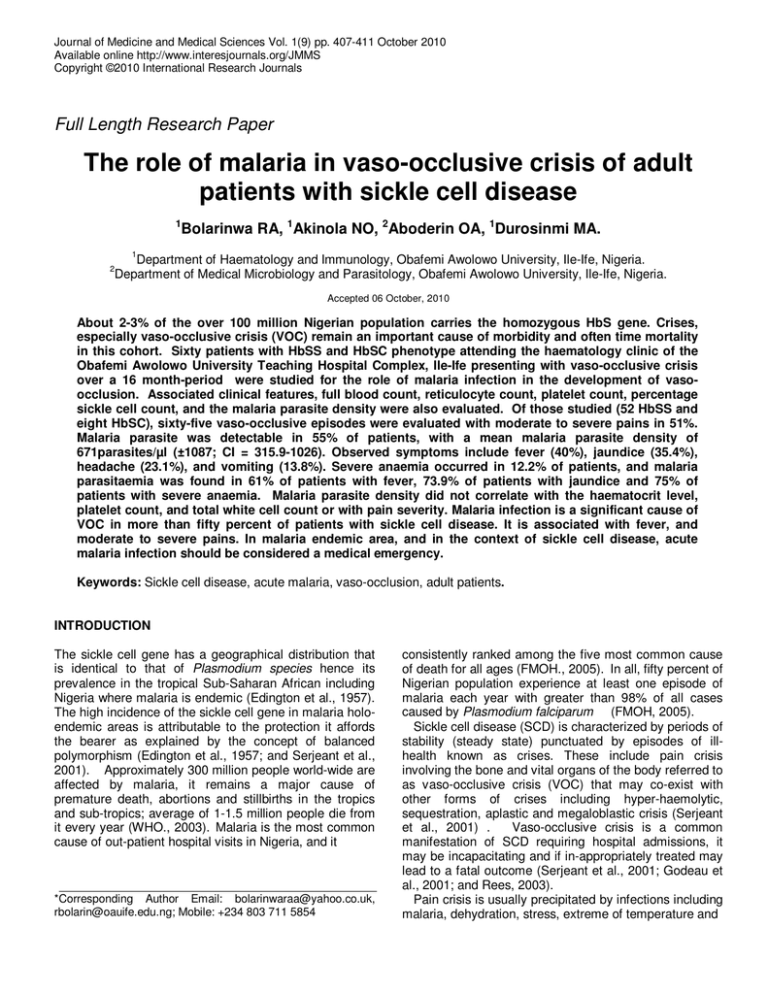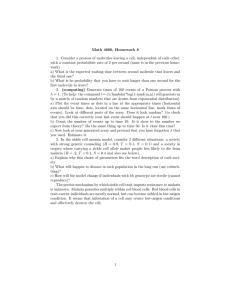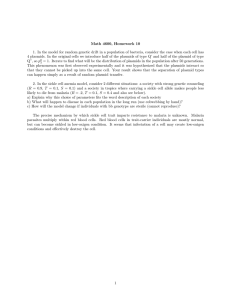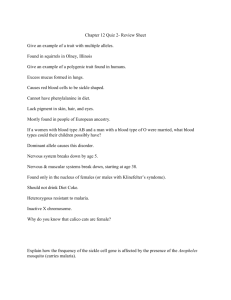Document 14233868
advertisement

Journal of Medicine and Medical Sciences Vol. 1(9) pp. 407-411 October 2010 Available online http://www.interesjournals.org/JMMS Copyright ©2010 International Research Journals Full Length Research Paper The role of malaria in vaso-occlusive crisis of adult patients with sickle cell disease 1 Bolarinwa RA, 1Akinola NO, 2Aboderin OA, 1Durosinmi MA. 1 Department of Haematology and Immunology, Obafemi Awolowo University, Ile-Ife, Nigeria. Department of Medical Microbiology and Parasitology, Obafemi Awolowo University, Ile-Ife, Nigeria. 2 Accepted 06 October, 2010 About 2-3% of the over 100 million Nigerian population carries the homozygous HbS gene. Crises, especially vaso-occlusive crisis (VOC) remain an important cause of morbidity and often time mortality in this cohort. Sixty patients with HbSS and HbSC phenotype attending the haematology clinic of the Obafemi Awolowo University Teaching Hospital Complex, Ile-Ife presenting with vaso-occlusive crisis over a 16 month-period were studied for the role of malaria infection in the development of vasoocclusion. Associated clinical features, full blood count, reticulocyte count, platelet count, percentage sickle cell count, and the malaria parasite density were also evaluated. Of those studied (52 HbSS and eight HbSC), sixty-five vaso-occlusive episodes were evaluated with moderate to severe pains in 51%. Malaria parasite was detectable in 55% of patients, with a mean malaria parasite density of 671parasites/µl (±1087; CI = 315.9-1026). Observed symptoms include fever (40%), jaundice (35.4%), headache (23.1%), and vomiting (13.8%). Severe anaemia occurred in 12.2% of patients, and malaria parasitaemia was found in 61% of patients with fever, 73.9% of patients with jaundice and 75% of patients with severe anaemia. Malaria parasite density did not correlate with the haematocrit level, platelet count, and total white cell count or with pain severity. Malaria infection is a significant cause of VOC in more than fifty percent of patients with sickle cell disease. It is associated with fever, and moderate to severe pains. In malaria endemic area, and in the context of sickle cell disease, acute malaria infection should be considered a medical emergency. Keywords: Sickle cell disease, acute malaria, vaso-occlusion, adult patients. INTRODUCTION The sickle cell gene has a geographical distribution that is identical to that of Plasmodium species hence its prevalence in the tropical Sub-Saharan African including Nigeria where malaria is endemic (Edington et al., 1957). The high incidence of the sickle cell gene in malaria holoendemic areas is attributable to the protection it affords the bearer as explained by the concept of balanced polymorphism (Edington et al., 1957; and Serjeant et al., 2001). Approximately 300 million people world-wide are affected by malaria, it remains a major cause of premature death, abortions and stillbirths in the tropics and sub-tropics; average of 1-1.5 million people die from it every year (WHO., 2003). Malaria is the most common cause of out-patient hospital visits in Nigeria, and it *Corresponding Author Email: bolarinwaraa@yahoo.co.uk, rbolarin@oauife.edu.ng; Mobile: +234 803 711 5854 consistently ranked among the five most common cause of death for all ages (FMOH., 2005). In all, fifty percent of Nigerian population experience at least one episode of malaria each year with greater than 98% of all cases caused by Plasmodium falciparum (FMOH, 2005). Sickle cell disease (SCD) is characterized by periods of stability (steady state) punctuated by episodes of illhealth known as crises. These include pain crisis involving the bone and vital organs of the body referred to as vaso-occlusive crisis (VOC) that may co-exist with other forms of crises including hyper-haemolytic, sequestration, aplastic and megaloblastic crisis (Serjeant et al., 2001) . Vaso-occlusive crisis is a common manifestation of SCD requiring hospital admissions, it may be incapacitating and if in-appropriately treated may lead to a fatal outcome (Serjeant et al., 2001; Godeau et al., 2001; and Rees, 2003). Pain crisis is usually precipitated by infections including malaria, dehydration, stress, extreme of temperature and 408 J. Med. Med. Sci. often time, no underline cause may be found (Serjeant et al., 2001). Vaso-occlusive crisis is unarguably complex involving multiple interactions of sickled red blood cells with the leucocytes and the vascular endothelium. The replacement of β6 glutamic acid with valine causes a hydrophobic interaction between haemoglobin molecules which when de-oxygenated forms aggregate of large insoluble polymers and subsequently dense cells (Bunn, 1997). The increase in the percentage of poorly deformable dense red cells has been demonstrated to be aetiologically related to the onset of pain crisis, it precedes the acute phase changes seen in VOC (Akinola et al., 1992a,b). The polymerization of HbS and its reduced deformability leads to significant increase in the viscosity of whole blood and formation of rigid cells that cause mechanical obstruction to the microcirculation. One of the mechanisms for vaso-occlusion is the abnormal adherence of sickled red blood cells, white blood cells and/or platelets to the vascular endothelium (Akinola et al., 1992). The reversibility of VOC and widespread tissue necrosis also indicate possible roles of vasospasm and inflammation (Osariogiagbon et al., 2000; and Graido-Gonzalez et al., 1998). The possibility of tissue injury and inflammation as a significant factor in VOC is also confirmed by the elevation of acute phase reactants, cytokines, cell adhesion molecules, and vaso-active substances including intercellular adhesion molecule-1 (ICAM-1) and E-selectin (Akinola et al., 1992; Akinola et al., 1992; and Osariogiagbon, 2001). The levels of acute phase proteins and serum Amyloid-A protein are also shown to be elevated (Stuart et al.,1994). Studies in transgenic sickled mice showed higher levels of baseline of markers of oxidative stress, such as ethane excretion and OH- radical generation than did their normal counterpart (Osariogiagbon, 2001). It is however noted that there is dearth of local work on the assessment of pain severity, vis-à-vis the role of malaria infection, clinical presentation and treatment outcome of the individuals with SCD, this study therefore aimed to assess the role of malaria infection in the development and severity of VOC (assessed by using visual analogue scale) and some laboratory parameters (haematocrit, percentage sickled red cell count, white blood cell count and platelet count) and clinical parameters on the one hand, and the effect of routine treatment intervention on the other hand. This is aimed at improving the management of a very common presentation of sickle cell disease. PATIENTS AND METHODS Prospective study of consecutive 60 SCD patients with VOC seen at the haematology day-care unit or the adult casualty of the Obafemi Awolowo University Teaching Hospitals’ Complex, Ile-Ife over a period of 16 months (May 2004-September 2005), covering a period of both low and high malaria transmission. They have been previously confirmed HbSS or HbSC at our facility (by method of haemoglobin electrophoresis), and are regular patients at the haematology outpatient clinic. None was on hydroxyurea. Patients were counseled to report at the earliest onset of VOC. Ethical clearance certificate (Protocol Number ERC/2004/04/18) was obtained from the Research and Ethics Committee of the hospital, all the patients gave informed consent. All participating patients were interviewed using a structured questionnaire, clinically examined, and were investigated (malaria parasite density count, blood culture, radio-diagnosis etc) to determine the cause of their VOC. Vaso Occlusive Crisis is defined as a painful crisis characterized by vascular occlusion and/or tissue infarction (in a patient with HbSS or HbSC phenotype) severe enough to necessitate hospital visit. The intensity of pain was determined using the visual analogue scale (VAS) as previously described (Jensen et al., 1986; and McCaffery et al., 1999). Five milliliter (5ml) of venous blood was collected in ethylene di-amine tetra acetic acid (EDTA) anticoagulated bottle to determine the malaria parasite density (MPD), haematocrit, WBC count, platelet count and the percentage sickled red cell. All patients were treated appropriately and were subsequently followed up on out-patient or in-patient basis. Patients with pains not related to HbS gene, and those that have used anti-malaria before presentation at the hospital were excluded from the study. Data was analyzed using descriptive and inferential statistics and a p-value <0.05 was considered significant. The SPSS-11 computer software (SPSS Inc. 1981-2001, Chicago, USA) was used for all data analysis. RESULTS There were 52(87%) HbSS and eight (13%) HbSC patients, consisting of 36 females (60%) and 24 males (40%) with a ratio of 1:1.5 (M: F). Table 1 showed the demography of the groups of the study population. The age ranged from 16 to 60 years with a mean age (±SD) of 25.3 (± 9.7) years. A total of 65 pain episodes were recorded in all the patients, one patient had three VOC episodes; three patients had two VOC episodes each, while the remaining 56 patients reported one episode of VOC during the study period. The location of pains varied from and within patients; limbs including joints (55.9%), back/spine (47.3%), chest (45%), abdomen (13.8%), and priapism (1.5%) recorded in one male patient. Menstruation-related pain was found in six (18.2%) of the female patients. The involvement of a single pain site was noted in 44.6%, two pain sites in 30.8% and three or more pain sites in 24.6% of patients. The severity of pain using the VAS was found to be: severe to very severe pain (22%), moderate pain (29%), and mild pain (49%). There was no significant gender variation in pain severity at presentation. In addition to pain-crisis, fever was recorded in 40% of patients; vomiting (13.8%); worsening jaundice (35.4%); weakness (12.2%), severe anaemia (12.2%), splenomegaly (12.3%) and dysuria (1.5%) (Table 2). Eighty percent of patient had used one or more analgesics before presentation at the hospital, and this seems to influence pain severity at presentation. Commonly used analgesic include: acetaminophen (52%), non steroidal anti-inflammatory drugs (42%), coproxamol (17%), DF-118 (5%). Precipitant of pain crisis Bolarinwa et al. 409 Table 1. Demographic data of males and females in the study populations HbSS HbSC Total Male (n) Mean age (yrs) + SD CI Female (n) Mean age (yrs) + SD CI 21 3 24 24.5 29.0 25.1 11.1 5.4 10.5 20.1- 28.8 23.8- 34.7 21.3- 29.0 31 5 36 23..9 34.4 25.5 7.2 13..9 9.0 21.4- 26.6 23.1- 47.3 22.5- 28.4 SD, standard deviation; CI, confidence interval; age in years Table 2. The incidence of clinical features in 65 VOC episodes in relation to the percentage of malaria parasitaemia. Clinical features Pains Hepatomegaly Fever Jaundice Leucocytosis [>11.0 x 109/L] Headache Vomiting Splenomegaly Anaemia [PCV<18%](all HbSS) Hepatosplenomegaly (all HbSS) Cough Thrombocytosis [>400 x 109/L] Weakness Diarrhea Dysuria was found in fifty one (78.5%) cases of VOC episodes, causes include: malaria infection (55.4%); non malaria infection (lobar pneumonia, urinary tract infection, opthalmitis, viral exanthema) (12.3%) and amongst those with malaria infection, co-morbidity with malaria was found in 10.8%. Menstruation-related pain was recorded in 9.2% and no apparent cause of pain crisis was found in eight (12.3%) pain episodes. Of the 36 cases (55.4%) of pain crisis that had associated malaria parasitaemia at presentation, the mean parasite density (MPD) was 671±1087 parasites/µL, ranging from 232 parasites/µL to 6885 parasites/µL. Severity of pain did not increase significantly with increasing malaria parasite density amongst the group with positive malaria smear. Those with fever had a significantly (F test=6.625; p=0.012) higher mean value of malaria parasitaemia (1031±1536.8 parasites/µL) when compared with those that did not have fever associated with their malaria parasitaemia (431.54±538.5 parasites/µL). The percentage sickle cell count significantly correlated with MPD (r=0.3; p=0.017). Incidence [%] 100 44.6 40 35.4 35.4 23.1 13.8 12.3 12.2 9.2 7.7 7.7 6.2 4.6 1.5 % with malaria parasitaemia 55.4 58.8 61.5 73.9 43.9 53.3 77.8 37.5 75 50 80 40 50 33.3 0 However, other indices evaluated did not revealed any statistically significant positive or negative relationship with MPD (Table 3). Haematological parameters Eight cases (12.3%) of VOC episodes had haematocrit below 18% and six of them had symptomatic anaemia requiring packed cells transfusion. Twenty three (35.4%) VOC episodes had leucocytes count >11,000/ml and five cases had platelet count >400,000/ml. Neither pain frequency nor pain severity showed significant correlation with haematocrit, leucocyte count or platelet count. Treatment Outcome A total of 48 (73.8%) VOC episodes were managed as day-care admission with fluid therapy, analgesics and appropriate treatment of underline cause of VOC where identified. The remaining cases were in-patients for a 410 J. Med. Med. Sci. Table 3. Correlation coefficients (r) between haematological/clinical variables and malaria parasitaemia at presentation of VOC Variable Haematocrit Reticulocyte count Platelet count Leucocyte count Absolute Neutrophil count Sickle cell count percentage Liver size Spleen size Severity of pain Transfusion episode with VOC period of 2-9 days (average 5.3 days). The choice of analgesic was influenced by the severity of pain at presentation and treatment offered according to the WHO pain management ladder scale. A combination of two or more analgesics was used in 31(47.7%) pain episodes. The pattern of analgesic use showed NSAID (86.2%), co-proxamol (52.3%), pethidine (32.3%), DF118 (30.8%), acetaminophen (18.5%), tramadol (12.3%), and pentazocine (10.8%). Morphine was not available in our facility at the time of this study. The group of patients treated as day-case had complete resolution of their pain crisis within 72 hours of onset. Six VOC episodes with associated life threatening anaemia had packed cells transfusion. No mortality was recorded. DISCUSSION This study has attempted to demonstrate beyond doubt the association between VOC and acute malaria infection, in addition to other pertinent clinical issues related to sickled vaso-occlusion. Malaria precipitated VOC in more than fifty percent of cases. This study also showed that the percentage sickled cells correlated significantly with the levels of malaria parasite density alluding to the significance of red cell parasitization in its genesis. The severity of Plasmodium falciparum malaria is related to its invasion of the red cells of all ages and the erythropoietic stem cells in the bone marrow, parasitized cells produce projecting knobs that adhere to the endothelial lining of the blood vessels with resulting haemolysis, obstruction and local hypoxia (WHO., 2003; and Cook et al., 2003). The role of hypoxia and repeated cycle of sickling and unsickling in the genesis of irreversible sickled cell formation has earlier been suggested (Shen et al., 1949; and Padilla et al., 1973). The majority of the patients were below 30 years of age reflecting the cohort of patients attending the sickle cell clinic, this confirm earlier reports (Cook et al., 2003; and Platt et al., 1994) of a high incidence of VOC in younger patients. r-value -0.159 0.107 0.129 0.072 0.133 0.30 0.018 -0.116 0.197 0.08 p-value 0.21 0.39 0.31 0.57 0.29 0.019 0.886 0.356 0.115 0.525 In a previous Jamaican study (Serjeant et al., 1994), a higher incidence of VOC in males was documented; this study did not show a significant gender variation in the incidence of VOC. The sites of pain at presentation of VOC were similar to previous report (Sergeant et al., 1994). The incidence of VOC associated malaria was observed to be 55.4%; higher than the 40% documented in a previous report (Ibidapo et al., 2000) of acute sickle cell syndromes among Nigerians. The observed increase may be related to a higher malaria endemicity, poor malaria prophylaxis or a yet unidentified factor by this study. Malaria is characterized by periodic paroxysms that are closely related to events in the blood stream; the febrile stage is characterized by spiking fever that presumably coincides with the invasion of new red cells (Cook et al., 2003; and Platt et al., 1994). However, in this study, fever contrary to expectation was not a constant feature seen in all the patients; it was observed that fever when present, correlated with high levels of malaria parasitaemia. In a previous report of patients with SCD in the steady state (Durosinmi et al., 2005), a mean value of 395±467 parasites/µl was documented for asymptomatic malaria parasitaemia; this value is lower than the mean (671±1087 parasites/µl) obtained in this study for malaria-associated VOC, far more less in those group with associated fever (1031±1536parasites/µl). This further confirm the importance of malaria in the precipitation of pain crisis. The use of antipyretics before presentation in the present work could have contributed to the absence of fever in some patients. Other clinical features that were associated with malaria parasitaemia included jaundice, vomiting and severe anaemia being observed in less than 50% of patients, but when they did occur, malaria infection should be suspected. Although, leucocytosis occurred more frequently in VOC, it did not occur in all patients and neither did it correlate with malaria parasitaemia contrary to expectation. Leucocytosis had been reported to occur in malaria infection (Ibidapo et al., 2000; and Nicholas et al., 1998) and it is also a feature of acute Bolarinwa et al. 411 phase response and reperfusion injury (Osariogiagbon et al., 2000), therefore should have occurred in all patients; the use of non-steroidal anti-inflammatory agent prior to presentation of pain-crisis might be responsible for our observation. Adequate use of analgesic and day-ward nursing care has contributed to the observed pain treatment outcome as previously noted by other authors (Zempsky et al., 2008 and Raphael et al., 2008). CONCLUSION Pain crisis remain a major morbidity in SCD and malaria infection appeared as the primary precipitating condition in more than fifty percent of cases. There was associated fever, jaundice with the VOC being moderate to severe in nature. In malaria endemic areas, and in the context of sickle cell disease, malaria should be considered a medical emergency. A thorough clinical assessment of pain in VOC, treatment of underline cause and adequate use of analgesic assures a good clinical outcome and short hospital stay. Day-care treatment remains invaluable in the management of the disorder. A case-controlled, multicenter study will further enhance the understanding of the role of malaria in SCD patients. REFERENCES Akinola NO, Stevens SME, Franklin IM (1992). Sub-clinical ischaemic episodes during the steady state of sickle cell anaemia. J. Clin. Pathol. 45:902-906. Akinola NO, Stevens SME, Franklin M (1992). Rheological changes in the prodromal and established phases of sickle cell vaso-occlusive crisis. Br. J. Haematol. 81:598-602. Bunn FH (1997). Pathogenesis and treatment of sickle cell disease. N. Engl. J. Med. 337 (11): 762- 769. st Cook GC, Zumk A (editors) (2003). Manson’s Tropical Disease, 21 ed. Saunders. Durosinmi MA, Salawu L, Aken’ova YA (2005). Haematological parameters in sickle cell anaemia patients with and without splenomegaly. Niger. Postgrad. Med. J. 12 (4): 271-274. Edington GM, Laing WN (1957). Relationship between haemoglobin C and S and malaria in Ghana. Br. Med. J. 144:143-145. FMOH (2005). National antimalaria treatment policy and guidelines. Federal Ministry of Health, National malaria and vector control division, Abuja, Nigeria. Godeau B, Noel V, Habibi A (2001). Sickle cell disease in adult: which emergency care by the internist? Rev. Med. Intern. 22(5):440-451. Graido-Gonzalez E, Doherty JC, Bergreen EW (1998). Plasma Endothelin –1,cytokine and prostaglandin E2 levels in sickle cell disease and Acute vaso- occlusive crisis. Blood. 92 (7): 2551-2555. Ibidapo MO, Akinyanju OO (2000). Acute sickle cell syndromes in Nigerian adults. Clin. Lab. Haematol. 22:151–155. Jensen M, Karoly P, Braver S (1986). The measurement of clinical pain intensity: a comparison of six methods. Pain. 27:117-126 McCaffery M, Pasero C (1999). Pain rating scale: In Pain: Clinical Manual. Mosby Inc. 63pp. Nicholas JW (1998). Malaria: In Gordon C, Editor, Manson’s tropical th diseases 20 ed. Saunders London; 1087-1164. Osariogiagbon UR (2001). Newer concepts of the pathogenesis of sickle cell disorder: The evidence for inflammation. Arch. Ibad. Med. 2(2): 41-45. Osariogiagbon UR, Choong S, Belcher JD (2000). Reperfusion injury Pathophysiology in sickle transgenic mice. Blood. 96:314-320. Padilla F, Bromberg PA, Jensen WN (1973). The sickle-unsickle cycle: a cause of cell fragmentation leading to permanent deformed cells. Blood. 41:653-660. Platt OS, Brambilla JD, Rose WF (1994). Mortality in sickle cell disease: Life expectancy and risk factors for early death. N. Engl. J. Med. 23 (330):1639-1644. Raphael JL, Kamdar A, Wang T (2008). Day hospital versus inpatient management of uncomplicated vaso-occlusive crises in children with sickle cell disease. Pediatr. Blood cancer. 51(3): 398-401. Rees DC (2003). Guideline: Guidelines for the management of the acute painful crisis in sickle cell diseases. Br. J. Haematol. 120(5): 744-752. Serjeant GR, Ceulaer CDE, Lethbridge R et al (1994). The painful crisis of homozygous sickle cell disease: Clinical Features. Br. J. Haematol. 87:586-591. rd Serjeant GR, Serjeant B.E (2001). Sickle cell diseases 3 ed; Oxford University press. Shen SC, Fleming EM, Castle WB (1949). Studies on the destruction of red blood cells : Irreversibly sickle erythrocytes : their experimental production in vitro. Blood. 4:498-504. Stuart J, Stone PCW, Akinola NO (1994). Monitoring the acute phase response to vaso-occlusive crisis in sickle cell disease. J. Clin. Pathol. 47:166-169. WHO (2003): Report of the scientific working group on malaria, Geneva, 24-27 March. Zempsky WT, Loiselle KA, Mckay K (2008). Retrospective evaluation of pain assessment and treatment for vaso occlusive episodesin children with sickle cell disease. Pediatr. Blood Cancer. 51(2): 265268.






